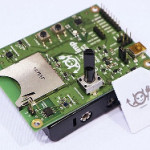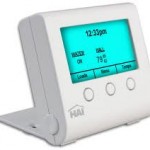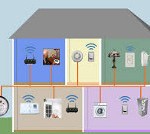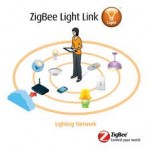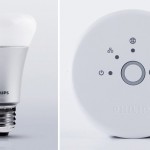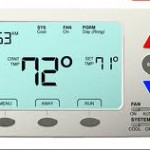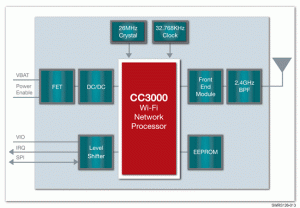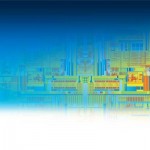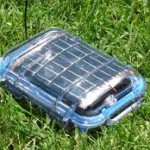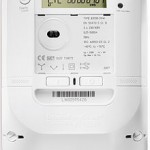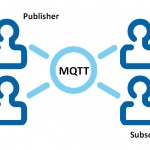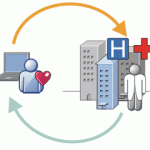Moving forward from our introduction to the Electric Imp platform, we’ll now consider how it can be integrated into existing or new designs for your commercial products. Using the Electric Imp platform can potentially simplify development complexity and the time-to-market – and doing so is a lot simpler than you can imagine.
Electric Imp integration with your design requires connecting Electric Imp’s backend with the Internet services that you want to use, such as email or Twitter notifications, existing Internet-of-Things data visualisation services like Xively, or your custom application-specific Web services or mobile apps. It also requires interfacing the 802.11b/g/n-connected Electric Imp hardware card with your hardware design.
For relatively easy integration of Internet connectivity into your existing microcontroller-based hardware design, the Electric Imp card can be used simply as a peripheral Wi-Fi gateway that is connected via serial UART to your microcontroller.
Your hardware design simply needs a host microcontroller with a spare 3.3V UART available and a 3.3V power rail with at least 400mA of available current capacity to power the card. A standard SD card socket is used for the Electric Imp, with pin 6 connected to the data line on the ATSHA204 IC which is required by Electric Imp as a unique identifier of each Electric Imp-enabled hardware device.
Note that pin 6 on the card socket must not be connected to ground as with the standard SD card pin-out, and this data line to the cryptography IC must be pulled to +3.3V with a 100k resistor.
A sufficiently large decoupling capacitor (preferably 2.2μF) must also be placed close to the card socket’s Vdd pin. With this simple hardware configuration an existing microcontroller design can be made “Imp-ready” for Internet connectivity (excluding the cost of the Electric Imp itself) at a very low cost – an additional cost of only about one dollar for the SD card socket and ATSHA204 IC in large volume.
Your existing microcontroller can exchange basic messages to and from the Electric Imp card over its serial UART, which can then send them on to the cloud. The Electric Imp IDE allows you to write server-side “agents” which make communication with the Electric Imp hardware easy. “Agent” code runs on Electric Imp’s servers and allows you to execute relatively heavy tasks such as HTTP requests, while “device” code runs on the local Electric Imp silicon.
Electric Imp easily passes messages between the agent and the device, so, for example, you can easily write agent code to allow Electric Imp to communicate with Web services targeted at the Internet of things, such as Xively, and that agent then communicates with the device.
This means, indirectly, that you have a chain of connectivity that is very easy to work with that connects your existing microcontroller to these Internet services. You can push your code down to an Internet-connected Electric Imp remotely, anywhere in the world, from Electric Imp’s web based IDE.
Manufacturers are able to push firmware updates from the cloud out to customer hardware in the field automatically – for example for bug fixes, upgrades or modifications to the APIs they use to talk to their web services.
For new designs built from scratch around Electric Imp, it may make more sense to use the power of the Electric Imp’s built-in microcontroller, and interface your sensors and actuators to the Electric Imp directly. This is likely to result in a reduction in the overall cost and complexity of your hardware system.
Thanks to Electric Imp’s cloud-based approach, your system has benefits like the ability to push firmware updates to customer’s hardware in the field, anywhere in the world, with just a few clicks. Electric Imp development doesn’t require downloading and installing an SDK, or connecting a JTAG probe to your target hardware.
You simply develop your code in Electric Imp’s browser-based IDE and it is pushed down to the Electric Imp over the Internet from Electric Imp’s servers.
For commercial use, where you’re integrating the Electric Imp into a product that you’re marketing commercially and connecting the backend to your own service via a HTTP API, you need to pay service fees to Electric Imp.
As a vendor of a commercial Electric Imp connected product, you can pre-pay for Electric Imp service for many years, or opt to be billed annually for each of your active Electric Imp devices in the field that are enabled and used by customers. This is their model for applications where your product designers are using Electric Imp technology for Internet communications – and with your own app in the Apple iTunes and/or Google Play stores, without Electric Imp branding.
The alternative is that the product designer just incorporates a card socket and ATSHA204 “CryptoAuthentication” IC into their product, which makes the product “Electric Imp Ready”. The user can then plug in their own Electric Imp card and pay a fee to use Electric Imp’s own branded service, allowing many different kinds of devices to be connected to services such as Twitter, SMS and email notifications.
Due to the ATSHA204′s unique serial number, each hardware device can be uniquely detected and thus tell the Electric Imp servers what kind of Imp-enabled device it is when the Imp is plugged into it, and the Imp can then download the appropriate firmware from the cloud for that application. This offers a very simple method of setup and firmware maintenance that can be remotely-controlled and out of the hands of the end-user.
No matter your level of technical proficiency, the Electric Imp platform offers a level of Internet-of-Things integration to match your product or design requirements. Furthermore, your new product’s time-to-market or the time to integrate Electric Imp into existing products is much smaller than existing embedded Wi-Fi solutions.
Here at the LX Group we’ve already completed a variety of products that embed the Electric Imp platform, and are ready to offer our experience and know-how on this and every other stage of product development to meet your needs. As we say – “LX can take you from the whiteboard to the white box”. So for a confidential discussion about your ideas and how we can help bring them to life – click here to contact us, or telephone 1800 810 124.
LX is an award-winning electronics design company based in Sydney, Australia. LX services include full turnkey design, electronics, hardware, software and firmware design. LX specialises in embedded systems and wireless technologies design. https://lx-group.com.au
Published by LX Pty Ltd for itself and the LX Group of companies, including LX Design House, LX Solutions and LX Consulting, LX Innovations.

